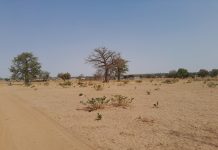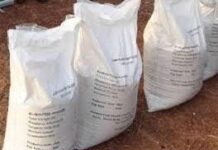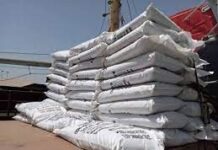PART 1
This column is devoted to monitor and report on issues relating to food  security in the Gambia as well as the interventions of Government and Non-governmental Organizations.
In this edition, we are focusing on the agricultural programs geared toward food security as well as the experiences of farmers regarding the impact of such programs on their lives.
Since 2000, a number of programs aimed at increasing food security have been elaborated and are in various stages of implementation.
In addition, government harmonized its sector policies and programs with global and regional initiatives such as the Millennium Development Goals
(MDGs), the Comprehensive Africa Agriculture Development Programme
(CAADP) of the New Partnership for Africa’s Development (NEPAD), and the Common Agriculture Policy (ECOWAP) of the Economic Community of West African States {ECOWAS).
During the decade, the priorities of the sector have been to achieve sustainable food security at the household and national levels. Toward this end, there are calls for the Agriculture and Natural Resource sector to be commercialized, while at the same time linking small and medium producers to improved technologies and markets, and increasing the competitiveness of the sector by reducing the domestic production costs, and improving quality.
The institutional structure of the sector is also being reformed to enable it meet the emerging trends. For example, given the increasing population of the country, there is more pressure on the land, and increased demands for food and better living standards. Furthermore, the relatively high poverty levels in the country pose serious threats to sustainable human development.
Against this background, there is now heightened awareness that the ANR sector can make significant contributions to national development. The sector has potential to enable the country attain self-sufficiency in food production, and make significant contributions to employment and incomes particularly for women and youths, as well as for development and growth.
For this reason, a new ANR policy has been elaborated to provide a framework for taking Gambian agriculture into the next century.
The ANR policy thus aims for a “robust, market oriented, commercialized sector that is directly aligned with the macro-economic framework of the country,” and contributes to the attainment of a “shared, inclusive and sustainable poverty reduction and economic growth in the Gambia.”
The ANR policy has four strategic objectives to be attained by 2015, and they are:
1). Improved and sustainable measurable levels of food and nutrition security in the country in general and vulnerable populations in particular
2). A commercialized ANR sector ensuring measurable competitive, efficient, and sustainable food and agricultural value chains, and linkages to markets
3). Institutions (public and private) in the sector are strengthened, and providing needed services, strong and enabling environment, and reducing vulnerability in food and nutrition security
4). Sustainable effective management of the natural resource base of the sector
Gambia National Agricultural Investment Program (GNAIP)
In 2005, ECOWAS agreed on an Action Plan (2005- 2010) to implement both the CAADP, and ECOWAP. ECOWAS was then mandated to implement the Action Plan, and consequently, the Regional Agricultural Investment Program (RAIP), which supplements national programs within the framework of the CAADP. The RAIP is sub-divided into the following six sub-programs:
1). Development of Agricultural chains and market promotion
2). Improvement of water management
3). Prevention and management of food crises and other natural disasters
4). Improved management of the other shared resources
5). Sustainable farm development
6). Institutional capacity building for the implementation of the RAIP
A key step toward the formulation of the RAIP is the preparation of National Agricultural Investment Programs (NAIPs) of ECOWAS member states.
These NAIPs are expected to be harmonized and consolidated, and thus form the basis of the RAIP. Towards this end, the Government of The Gambia, embarked on preparing a NAIP, with its two CAADP implementing ministries, the Ministry of Agriculture (MOA), and the Ministry of Trade, Industry, and Employment (MOTIE), spearheading the process.
The GNAIP was prepared in a highly consultative and participatory manner aimed at producing a document that is not only of the highest quality, but also has the ownership of the widest spectrum of stakeholders (government agencies, non-governmental organizations and the private sector). As a framework, the GNAIP is aimed at helping achieve the policies objectives of the ANR policy, which ultimately help the country achieve the MDGs. The GNAIP also provides the Gambia’s agricultural investment program in the six areas identified in the RAIP. The program is thus deeply rooted both in the national, regional, and international development frameworks and agenda.
Part Two
In part one, it was indicated that since 2000, a number of programmes aimed at increasing food security have been initiated and are at various stages of implementation. In addition, government harmonized its sector policies and programmes with global and regional initiatives such as the Millennium Development Goals (MDGs), the Comprehensive Africa Agriculture Development Programme (CAADP) of the New Partnership for Africa’s Development (NEPAD), and the Common Agriculture Policy (ECOWAP) of the Economic Community of West African States {ECOWAS).
Part One showed that during the decade, the priorities of the sector have been to achieve sustainable food security at the household and national levels and toward this end, there were calls for the Agriculture and Natural Resources sector to be commercialized, while at the same time linking small and medium producers to improved technologies and markets, and increasing the competitiveness of the sector by reducing the domestic production costs, and improving quality.
In this edition, we shall deal with Development of Agricultural Chains and Market Promotion as contained in the Gambia National Agricultural Investment Program blueprint.
DEVELOPMENT OF AGRICULTURAL CHAINS AND MARKET PROMOTION
The Gambia produces a wide range of agricultural products which can be processed for both domestic consumption and export marketing.
However, the agro-industry in the Gambia is limited because the vast majority of the perishable farm produce have virtually no value addition after their production.
These products are not processed, but are consumed in their primary condition. As a result, these perishable products are often wasted, or sold at a give away price.
Agricultural chains can make significant contributions to the ANR sector in the Gambia by helping to transform it from a traditional subsistence form to a commercial and modern one. This is because agro-industries and related activities help improve the efficiency of value chains of high value commodities for which the country has comparative advantages in producing, provide sustainable sources of income and employment, and can help the country fight cheap food imports.
Like the food production sub-sector, the agri-business and agro-processing sub-sectors are characterized by many smallholders using low output technologies, and labour intensive systems, resulting in poor quality products and low income. These sub-sectors also face many constraints such as poor feeder road network, inconsistent power supply, and weak local demand.
Additional challenges include a poor communication network, undeveloped food retailing, and lack of a temperature-controlled distribution chain.
Given the relatively small size of the Gambian market, the country has to tap regional and international markets if the sector is to achieve significant growth.
Against this background, the National Agricultural Investment Program includes a sub-program on the development of agricultural chains and market promotion.
In line with the thematic areas of the Regional Agricultural Investment Program for West Africa, this sub-program has three components namely: the development of food processing chains, strengthening of regional operator support services, and the promotion of intra-regional and extra-regional trade.
DEVELOPMENT OF FOOD PROCESSING CHAINS
The food processing sub-sector is important because of its direct link with agriculture, its contribution to food security for the nation, and its potential as foreign exchange saver through efficient import substitution.
However, there is little evidence of a coordinated, integrated, national strategy for agro-food industry in The Gambia.
This is a major constraint to efficiency of the various public and private organizations working in or on behalf of the industry.
The Gambian farmers have access to little or no processing and preservation technology, particularly female horticultural producers. They still use the traditional preservation techniques such as sun-drying, salting, fermenting, smoking, roasting and grinding.
Besides, the sector mainly comprises grain-milling and edible oil extraction at the community-based level.
The vast majority of fruits and vegetables have virtually no value added to them. Fruits and vegetables are among the readily perishable commodities, which form an important part of The Gambia’s food supplies. The storage of fruit and vegetables in the rural areas is one out of several post-harvest constraints that farmers are experiencing each year.
The food processing activity in the Gambia is significantly constrained by inadequate quality of raw material, high post-harvest wastage levels (30-
50 percent), high production costs, and low capacity utilization.
Additional constraints include the absence of cold-chain, non-availability of. packaging material, limited access to credit, inadequate support services, absence of regulatory framework, unreliable supply of factor inputs, undeveloped consumer taste for processed foods, and a weak marketing and distribution system.
The government will address the sector-wide constraints through a strategy of public and private sector partnership. Toward this end, the private sector is expected to assume a lead role in the provision of enterprise investment resources and entrepreneurial management to be facilitated by public sector catalytic roles.
Has this program been achieved? What is the situation of the farmers in terms of poverty and food insecurity?
PART THREE
In part Two, it was indicated that the Gambia produces a wide range of agricultural products which can be processed for both domestic consumption and export marketing.
However, the agro-industry in the Gambia is limited because the vast majority of the perishable farm produce have virtually no value addition after their production and that these products are not processed, but are consumed in their primary condition. As a result, these perishable products are often wasted, or sold at a give away price.
In part three which is this edition, Farmers’ Eye will deal with the Food Crop Chain in the Gambia and subsequent editions, show the huge economic benefit the country would gain by processing them for both domestic consumption and export marketing.
FOOD CROP CHAIN
The seven major crops grown in The Gambia are groundnuts, the coarse grains (millet, maize, and sorghum), as well as rice, sesame, findo.
An estimated 197,856 people were involved in the production of the seven food crops, which thus provide both a source of employment and livelihood.
Coarse grains production and the area planted to these grains have significantly increased in the past few years.
Millet is the most widely cultivated coarse grain, and the area under millet increased 55 percent from 57,100 hectares in 1995, to 127,300 hectares in 2005. About 51,000 households derive income from it.
However, groundnut is the most dominant one as it engages more people than any other crop. Rice, which is a staple food, engaged 1 0,091 people, less than the number of people cultivating millet and maize. The domestic market price for millet is showing an upward trend from 2001 to 2005, except in 2003/2004 where no significant increase was registered.
Maize produced is consumed and sold in the domestic market, and has been increasing in popularity, as indicated by area under cultivation.
However, production levels have varied over the past few years, from
27,700 tonnes in 2002, to 33,400 tonnes in 2003, and 29,200 tonnes in 2004.
In the same vein, prices have varied from D4, 920 per tonne in 2002 to
D7, 520 per tonne in 2004.
It provides a strong support to livestock sub sector, particularly poultry, in The Gambia. An increase in livestock production may stimulate maize production as maize is a livestock and poultry feed.
Findo, which almost disappeared from the farming system because of the difficulty in processing it, has been making a comeback in recent years. The crop has mainly been used as a buffer/reserve crop during the hungry season.
Groundnuts remain the country’s main cash crop, and it is estimated that
80 percent of rural households grow the crop on over 40 percent of the land under cultivation. The crop plays a central role in rural life, providing food, fodder and income, while also creating jobs in transport and processing, as well as foreign exchange (10.6 percent). According to the NASS 2005/2006 an estimated 105,260 households derive income from groundnuts cultivation throughout the country.
The recent Diagnostic Trade Integration Study (DTIS) under the Integrated Framework estimated that in 2006, 30,000 tonnes of commercially purchased groundnuts yield US$8.2 million for farm households.
This confirmed the significance of groundnuts in households’ income and hence the impact of revitalization of the sector on poverty in The Gambia.
Despite the sub-sector’s importance, groundnut farmers are among the poorest members in the Gambian society, with 76 percent classified as poor (Diagnostic Trade Integration Study, 2007).
Although most of these products are consumed at the household level, some are sold at the local market and in cross border trade. The products also have potential linkages with other sectors particularly the livestock sub-sector, where they serve as feeds for livestock and poultry. Consequently, these crops also support other income generating activities such as livestock and poultry production.
Additionally, they have potential for value addition activities such as production of flour and other processed products.
Part Four
In part three, the seven major crops grown in The Gambia namely groundnuts, the coarse grains namely millet, maize, and sorghum, as well as rice, sesame, findo were showed and it was also stated that the agro-industry in the Gambia is limited because the vast majority of the perishable farm produce have virtually no value addition after their production and that these products are not processed, but are consumed in their primary condition.
As a result, these perishable products are often wasted, or sold at a give away price.
In addition, promotion of agro-food processing would have significant positive impact on small farm holdings as it will provide them with a ready market for their produce. It would help to promote the development of cottage industries in the rural areas which may improve the income of the farmers.
The culture of quality control has to be built in the system in order to make it efficient.
Food crop production in the Gambia would be greatly improved if there is significant investment made in the following main areas:
Agricultural inputs and marketing
security in the Gambia as well as the interventions of Government and Non-governmental Organizations.
In this edition, we are focusing on the agricultural programs geared toward food security as well as the experiences of farmers regarding the impact of such programs on their lives.
Since 2000, a number of programs aimed at increasing food security have been elaborated and are in various stages of implementation.
In addition, government harmonized its sector policies and programs with global and regional initiatives such as the Millennium Development Goals
(MDGs), the Comprehensive Africa Agriculture Development Programme
(CAADP) of the New Partnership for Africa’s Development (NEPAD), and the Common Agriculture Policy (ECOWAP) of the Economic Community of West African States {ECOWAS).
During the decade, the priorities of the sector have been to achieve sustainable food security at the household and national levels. Toward this end, there are calls for the Agriculture and Natural Resource sector to be commercialized, while at the same time linking small and medium producers to improved technologies and markets, and increasing the competitiveness of the sector by reducing the domestic production costs, and improving quality.
The institutional structure of the sector is also being reformed to enable it meet the emerging trends. For example, given the increasing population of the country, there is more pressure on the land, and increased demands for food and better living standards. Furthermore, the relatively high poverty levels in the country pose serious threats to sustainable human development.
Against this background, there is now heightened awareness that the ANR sector can make significant contributions to national development. The sector has potential to enable the country attain self-sufficiency in food production, and make significant contributions to employment and incomes particularly for women and youths, as well as for development and growth.
For this reason, a new ANR policy has been elaborated to provide a framework for taking Gambian agriculture into the next century.
The ANR policy thus aims for a “robust, market oriented, commercialized sector that is directly aligned with the macro-economic framework of the country,” and contributes to the attainment of a “shared, inclusive and sustainable poverty reduction and economic growth in the Gambia.”
The ANR policy has four strategic objectives to be attained by 2015, and they are:
1). Improved and sustainable measurable levels of food and nutrition security in the country in general and vulnerable populations in particular
2). A commercialized ANR sector ensuring measurable competitive, efficient, and sustainable food and agricultural value chains, and linkages to markets
3). Institutions (public and private) in the sector are strengthened, and providing needed services, strong and enabling environment, and reducing vulnerability in food and nutrition security
4). Sustainable effective management of the natural resource base of the sector
Gambia National Agricultural Investment Program (GNAIP)
In 2005, ECOWAS agreed on an Action Plan (2005- 2010) to implement both the CAADP, and ECOWAP. ECOWAS was then mandated to implement the Action Plan, and consequently, the Regional Agricultural Investment Program (RAIP), which supplements national programs within the framework of the CAADP. The RAIP is sub-divided into the following six sub-programs:
1). Development of Agricultural chains and market promotion
2). Improvement of water management
3). Prevention and management of food crises and other natural disasters
4). Improved management of the other shared resources
5). Sustainable farm development
6). Institutional capacity building for the implementation of the RAIP
A key step toward the formulation of the RAIP is the preparation of National Agricultural Investment Programs (NAIPs) of ECOWAS member states.
These NAIPs are expected to be harmonized and consolidated, and thus form the basis of the RAIP. Towards this end, the Government of The Gambia, embarked on preparing a NAIP, with its two CAADP implementing ministries, the Ministry of Agriculture (MOA), and the Ministry of Trade, Industry, and Employment (MOTIE), spearheading the process.
The GNAIP was prepared in a highly consultative and participatory manner aimed at producing a document that is not only of the highest quality, but also has the ownership of the widest spectrum of stakeholders (government agencies, non-governmental organizations and the private sector). As a framework, the GNAIP is aimed at helping achieve the policies objectives of the ANR policy, which ultimately help the country achieve the MDGs. The GNAIP also provides the Gambia’s agricultural investment program in the six areas identified in the RAIP. The program is thus deeply rooted both in the national, regional, and international development frameworks and agenda.
Part Two
In part one, it was indicated that since 2000, a number of programmes aimed at increasing food security have been initiated and are at various stages of implementation. In addition, government harmonized its sector policies and programmes with global and regional initiatives such as the Millennium Development Goals (MDGs), the Comprehensive Africa Agriculture Development Programme (CAADP) of the New Partnership for Africa’s Development (NEPAD), and the Common Agriculture Policy (ECOWAP) of the Economic Community of West African States {ECOWAS).
Part One showed that during the decade, the priorities of the sector have been to achieve sustainable food security at the household and national levels and toward this end, there were calls for the Agriculture and Natural Resources sector to be commercialized, while at the same time linking small and medium producers to improved technologies and markets, and increasing the competitiveness of the sector by reducing the domestic production costs, and improving quality.
In this edition, we shall deal with Development of Agricultural Chains and Market Promotion as contained in the Gambia National Agricultural Investment Program blueprint.
DEVELOPMENT OF AGRICULTURAL CHAINS AND MARKET PROMOTION
The Gambia produces a wide range of agricultural products which can be processed for both domestic consumption and export marketing.
However, the agro-industry in the Gambia is limited because the vast majority of the perishable farm produce have virtually no value addition after their production.
These products are not processed, but are consumed in their primary condition. As a result, these perishable products are often wasted, or sold at a give away price.
Agricultural chains can make significant contributions to the ANR sector in the Gambia by helping to transform it from a traditional subsistence form to a commercial and modern one. This is because agro-industries and related activities help improve the efficiency of value chains of high value commodities for which the country has comparative advantages in producing, provide sustainable sources of income and employment, and can help the country fight cheap food imports.
Like the food production sub-sector, the agri-business and agro-processing sub-sectors are characterized by many smallholders using low output technologies, and labour intensive systems, resulting in poor quality products and low income. These sub-sectors also face many constraints such as poor feeder road network, inconsistent power supply, and weak local demand.
Additional challenges include a poor communication network, undeveloped food retailing, and lack of a temperature-controlled distribution chain.
Given the relatively small size of the Gambian market, the country has to tap regional and international markets if the sector is to achieve significant growth.
Against this background, the National Agricultural Investment Program includes a sub-program on the development of agricultural chains and market promotion.
In line with the thematic areas of the Regional Agricultural Investment Program for West Africa, this sub-program has three components namely: the development of food processing chains, strengthening of regional operator support services, and the promotion of intra-regional and extra-regional trade.
DEVELOPMENT OF FOOD PROCESSING CHAINS
The food processing sub-sector is important because of its direct link with agriculture, its contribution to food security for the nation, and its potential as foreign exchange saver through efficient import substitution.
However, there is little evidence of a coordinated, integrated, national strategy for agro-food industry in The Gambia.
This is a major constraint to efficiency of the various public and private organizations working in or on behalf of the industry.
The Gambian farmers have access to little or no processing and preservation technology, particularly female horticultural producers. They still use the traditional preservation techniques such as sun-drying, salting, fermenting, smoking, roasting and grinding.
Besides, the sector mainly comprises grain-milling and edible oil extraction at the community-based level.
The vast majority of fruits and vegetables have virtually no value added to them. Fruits and vegetables are among the readily perishable commodities, which form an important part of The Gambia’s food supplies. The storage of fruit and vegetables in the rural areas is one out of several post-harvest constraints that farmers are experiencing each year.
The food processing activity in the Gambia is significantly constrained by inadequate quality of raw material, high post-harvest wastage levels (30-
50 percent), high production costs, and low capacity utilization.
Additional constraints include the absence of cold-chain, non-availability of. packaging material, limited access to credit, inadequate support services, absence of regulatory framework, unreliable supply of factor inputs, undeveloped consumer taste for processed foods, and a weak marketing and distribution system.
The government will address the sector-wide constraints through a strategy of public and private sector partnership. Toward this end, the private sector is expected to assume a lead role in the provision of enterprise investment resources and entrepreneurial management to be facilitated by public sector catalytic roles.
Has this program been achieved? What is the situation of the farmers in terms of poverty and food insecurity?
PART THREE
In part Two, it was indicated that the Gambia produces a wide range of agricultural products which can be processed for both domestic consumption and export marketing.
However, the agro-industry in the Gambia is limited because the vast majority of the perishable farm produce have virtually no value addition after their production and that these products are not processed, but are consumed in their primary condition. As a result, these perishable products are often wasted, or sold at a give away price.
In part three which is this edition, Farmers’ Eye will deal with the Food Crop Chain in the Gambia and subsequent editions, show the huge economic benefit the country would gain by processing them for both domestic consumption and export marketing.
FOOD CROP CHAIN
The seven major crops grown in The Gambia are groundnuts, the coarse grains (millet, maize, and sorghum), as well as rice, sesame, findo.
An estimated 197,856 people were involved in the production of the seven food crops, which thus provide both a source of employment and livelihood.
Coarse grains production and the area planted to these grains have significantly increased in the past few years.
Millet is the most widely cultivated coarse grain, and the area under millet increased 55 percent from 57,100 hectares in 1995, to 127,300 hectares in 2005. About 51,000 households derive income from it.
However, groundnut is the most dominant one as it engages more people than any other crop. Rice, which is a staple food, engaged 1 0,091 people, less than the number of people cultivating millet and maize. The domestic market price for millet is showing an upward trend from 2001 to 2005, except in 2003/2004 where no significant increase was registered.
Maize produced is consumed and sold in the domestic market, and has been increasing in popularity, as indicated by area under cultivation.
However, production levels have varied over the past few years, from
27,700 tonnes in 2002, to 33,400 tonnes in 2003, and 29,200 tonnes in 2004.
In the same vein, prices have varied from D4, 920 per tonne in 2002 to
D7, 520 per tonne in 2004.
It provides a strong support to livestock sub sector, particularly poultry, in The Gambia. An increase in livestock production may stimulate maize production as maize is a livestock and poultry feed.
Findo, which almost disappeared from the farming system because of the difficulty in processing it, has been making a comeback in recent years. The crop has mainly been used as a buffer/reserve crop during the hungry season.
Groundnuts remain the country’s main cash crop, and it is estimated that
80 percent of rural households grow the crop on over 40 percent of the land under cultivation. The crop plays a central role in rural life, providing food, fodder and income, while also creating jobs in transport and processing, as well as foreign exchange (10.6 percent). According to the NASS 2005/2006 an estimated 105,260 households derive income from groundnuts cultivation throughout the country.
The recent Diagnostic Trade Integration Study (DTIS) under the Integrated Framework estimated that in 2006, 30,000 tonnes of commercially purchased groundnuts yield US$8.2 million for farm households.
This confirmed the significance of groundnuts in households’ income and hence the impact of revitalization of the sector on poverty in The Gambia.
Despite the sub-sector’s importance, groundnut farmers are among the poorest members in the Gambian society, with 76 percent classified as poor (Diagnostic Trade Integration Study, 2007).
Although most of these products are consumed at the household level, some are sold at the local market and in cross border trade. The products also have potential linkages with other sectors particularly the livestock sub-sector, where they serve as feeds for livestock and poultry. Consequently, these crops also support other income generating activities such as livestock and poultry production.
Additionally, they have potential for value addition activities such as production of flour and other processed products.
Part Four
In part three, the seven major crops grown in The Gambia namely groundnuts, the coarse grains namely millet, maize, and sorghum, as well as rice, sesame, findo were showed and it was also stated that the agro-industry in the Gambia is limited because the vast majority of the perishable farm produce have virtually no value addition after their production and that these products are not processed, but are consumed in their primary condition.
As a result, these perishable products are often wasted, or sold at a give away price.
In addition, promotion of agro-food processing would have significant positive impact on small farm holdings as it will provide them with a ready market for their produce. It would help to promote the development of cottage industries in the rural areas which may improve the income of the farmers.
The culture of quality control has to be built in the system in order to make it efficient.
Food crop production in the Gambia would be greatly improved if there is significant investment made in the following main areas:
Agricultural inputs and marketing
- Improved land tenure system
- Soil and water management
- v) Suitable crop varieties
- vi) Storage and preservation facilities (in addition, cold storage facilities for horticultural products)
- ix) Water supply systems (e.g. bole-holes, concrete-lined wells, etc)
- x) Irrigation system
- xi) Crop management
- Intensive and well organized production system/regime
- Horticultural Inputs
- iv) Horticultural information, education and communication
- Use of improved varieties, including rainy season-adapted varieties
- vi) Cold storage facilities
- Improved land tenure system
- iv) Agricultural information, education and communication
- v) Suitable crop varieties
- vi) Storage and preservation facilities (in addition, cold storage facilities for horticultural products)
- ix) Water supply systems (e.g. bole-holes, concrete-lined wells, etc.)
- x) Irrigation system
- xi) Crop management





















